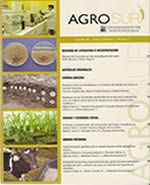Control of defoliation intensity on the seasonal and total forage production in dairy systems
Main Article Content
Abstract
This study aimed to determine the effect of controlling the intensity of defoliation (ID) on forage production and herbage disappearance in eight commercial farms, in a complete randomized block design. Two blocks were selected in each farm to compare, the grazing management routine of the farm (T0) vs. controlled management (T1, pre grazing height 15-20 cm and post grazing height 5-7 cm). Pre grazing sward height (SH), herbage mass (HM, kg DM ha-1) and daily growth rate (GR, kg DM ha-1 d-1) were determined. In average, SH was lower (p <0.05) in autumn (A) and winter (W) (15.5 ± 1.2 and 16.9 ± 1 cm) than in spring (Sp) and summer (Su) (19.8 ± 1.0 and 21.1 ± 1.2 cm). The same trend (p <0.05) followed HM (A: 1250 ± 164; W: 1476 ± 145; Sp: 1914 ± 140; Su: 2564 ± 167 kg DM ha-1). Average GR was 26.5% higher in T1 than in T0 (p <0.05), and significant differences remained throughout the seasons (A: 19.3 ± 4.3 vs 7.0 ± 3.9; W: 21.3 ± 3.4 vs 17.0 ± 3.0; Sp: 39.6 ± 9.0 vs 33.4 ± 2.5 Su: 43.5 ± 4.2 vs 39.7 ± 4, 0 kg DM ha-1 d-1; p <0.05, for T1 and T0 respectively). In average, T1 yielded 2336 kg DM ha-1 extra when compared to T0, 52% of that was produced in A (p<0.05). Herbage allowance (HA), HM, length of the grazing and SH explained most of the variation (R2 =0.75) of the disappeared forage per hectare (offered - rejected). Controlled grazing management increased herbage production and utilization by dairy cows.

